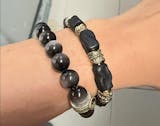The Cultural Significance of Tibetan Silver Rings: A Window into Tibetan Heritage
Introduction
Tibetan silver rings are more than just ornamental pieces; they are intricate embodiments of Tibetan culture, spirituality, and artisanal craftsmanship. These unique accessories offer a glimpse into the rich tapestry of Tibetan heritage, blending aesthetic appeal with profound symbolic meaning.

Historical Context
The tradition of Tibetan silver jewelry dates back centuries, with roots deeply intertwined with the region's spiritual and cultural practices. Historically, silver has been highly valued in Tibetan society, not only for its beauty but also for its perceived protective and healing properties. Tibetan silver rings, in particular, have served as both personal adornments and carriers of cultural significance.
Spiritual Symbolism
Many Tibetan silver rings feature intricate designs that incorporate Buddhist symbols and motifs. Common elements include:
- The Eight Auspicious Symbols (Ashtamangala): These include the parasol, golden fish, treasure vase, lotus, conch shell, endless knot, victory banner, and dharma wheel. Each symbol represents different aspects of Buddhist teachings and blessings.
- Mantras and Sacred Texts: Some rings are engraved with Buddhist mantras or excerpts from sacred texts, believed to offer protection and spiritual guidance to the wearer.
- Dorje (Vajra): This symbol of the thunderbolt represents the indestructible nature of truth and enlightenment.Wearing a vajra ring is good to protect you.
-
Om Mani Padme Hum: This popular mantra is often incorporated into ring designs, embodying the essence of Buddhist compassion.

Craftsmanship and Artistic Expression
Tibetan silver rings showcase the exceptional skill of Tibetan artisans. Traditional techniques such as filigree, repoussé, and stone setting are employed to create intricate designs. The craftsmanship involved in making these rings is often passed down through generations, preserving ancient techniques and artistic styles.The use of turquoise, coral, and other semi-precious stones in Tibetan silver rings adds both aesthetic value and symbolic meaning. Turquoise, for instance, is believed to promote health and ward off evil, while coral is associated with life force and vitality.
Cultural Identity and Personal Expression
For Tibetans, wearing silver rings is not just a fashion statement but a way to connect with their cultural roots and express their identity. In the face of cultural challenges and diaspora, these rings serve as tangible links to Tibetan heritage.Moreover, the choice of specific designs or symbols in a ring can reflect the wearer's personal spiritual journey, beliefs, or aspirations. For example, a ring featuring the endless knot might symbolize the wearer's commitment to the interconnectedness of all things.

Beyond Borders: Global Appeal
In recent years, Tibetan silver rings have gained popularity beyond Tibet, attracting interest from people around the world. This global appeal stems from several factors:
- Aesthetic Beauty: The unique designs and intricate craftsmanship make these rings stand out as distinctive pieces of jewelry.
- Spiritual Connection: Many people, regardless of their religious background, are drawn to the spiritual symbolism and perceived protective qualities of these rings.
- Cultural Appreciation: Wearing Tibetan silver rings can be a way for non-Tibetans to express appreciation for Tibetan culture and artistry.
- Ethical Consumerism: Some buyers are attracted to the idea of supporting traditional Tibetan craftsmanship and, by extension, Tibetan culture.
Challenges and Preservation
Despite their cultural significance, the tradition of Tibetan silver rings faces challenges. Modernization, changing fashion trends, and the complexities of Tibet's political situation all pose potential threats to this art form. However, efforts are being made to preserve and promote Tibetan silversmithing:
- Cultural Preservation Programs: Various organizations are working to document and teach traditional Tibetan jewelry-making techniques.
- Contemporary Adaptations: Some artisans are finding ways to blend traditional designs with modern aesthetics, ensuring the continued relevance of Tibetan silver rings.
-
Global Market Exposure: Increased international interest in Tibetan culture has created new markets for these rings, potentially helping to sustain the craft.

Conclusion
In conclusion, Tibetan silver rings are far more than mere accessories. They are portable pieces of Tibetan culture, embodying centuries of spiritual tradition, artistic expression, and cultural identity. As these rings continue to captivate people around the world, they serve as ambassadors of Tibetan heritage, inviting wearers and admirers alike to explore the rich cultural tapestry from which they emerge.
Related articles:
The Elegance and Benefits of Sterling Silver Rings for Men
Why Do Silver Rings Feature the Six-Word Mantra:Discovering Its Meaning and Significance
Feng Shui Rings: Meaning, Benefits, and How to Select
What Does the Dragon Ring Symbolize?
The Beauty and Craftsmanship of Bodhi Rings

























































